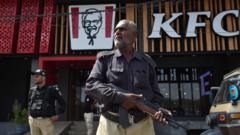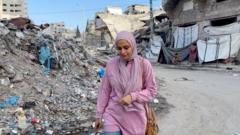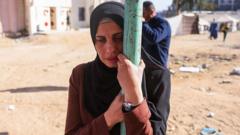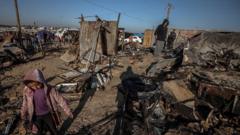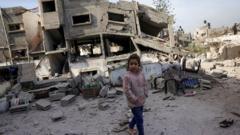A devastating uptick in violence marks the latest chapter in the ongoing conflict, raising urgent humanitarian concerns for the civilian population in Gaza.
**Escalating Conflict: Gaza Crisis Deepens Amid Renewed Bombardment**

**Escalating Conflict: Gaza Crisis Deepens Amid Renewed Bombardment**
Intense Israeli Airstrikes Lead to Rising Casualties in Gaza as Cease-Fire Collapses
As the conflict between Israel and Hamas escalates, the Gaza Strip is facing severe repercussions from a renewed Israeli military offensive, with health officials reporting that over 90 Palestinians have died in the past 48 hours alone. The strikes have heightened the already dire humanitarian situation, as the territory's health ministry indicated on Sabbath morning that hospitals have been overwhelmed with injuries, totaling 219 wounded.
This latest wave of violence follows the breakdown of a cease-fire agreement last month, prompting Israel’s military to intensify its airstrikes and ground operations, asserting that its efforts are focused on militants and military infrastructure to pressure Hamas into releasing hostages. The ongoing assault has claimed more than 1,700 lives in the past month and over 51,000 since the conflict erupted in October 2023, speaking to the tragic scale of the situation.
Residents of Gaza are left searching for shelter, yet find that many locations once deemed safe, like the Mawasi area, are no longer recognized as “humanitarian zones” by Israeli forces. Although the military had previously instructed citizens to seek refuge there, a sudden shift in classification leaves many feeling abandoned and vulnerable. Difficult circumstances have led to tent encampments in Mawasi, but clarity regarding its safety status has been notably lacking, raising concerns regarding the dissemination of critical information to the civilians affected.
Confusion reigns over casualty reporting, as the health ministry does not specify the nature of the casualties, while the Palestinian Civil Defense claims to have recovered bodies across various regions of Gaza in recent days. Amid this tragic backdrop, the resilience of the Gazan populace is tested, with many grappling with the harsh reality that nowhere feels truly safe any longer. Adam Rasgon continues to report from Jerusalem, focusing on the complexities of Israeli-Palestinian relations amidst escalating tensions.
This latest wave of violence follows the breakdown of a cease-fire agreement last month, prompting Israel’s military to intensify its airstrikes and ground operations, asserting that its efforts are focused on militants and military infrastructure to pressure Hamas into releasing hostages. The ongoing assault has claimed more than 1,700 lives in the past month and over 51,000 since the conflict erupted in October 2023, speaking to the tragic scale of the situation.
Residents of Gaza are left searching for shelter, yet find that many locations once deemed safe, like the Mawasi area, are no longer recognized as “humanitarian zones” by Israeli forces. Although the military had previously instructed citizens to seek refuge there, a sudden shift in classification leaves many feeling abandoned and vulnerable. Difficult circumstances have led to tent encampments in Mawasi, but clarity regarding its safety status has been notably lacking, raising concerns regarding the dissemination of critical information to the civilians affected.
Confusion reigns over casualty reporting, as the health ministry does not specify the nature of the casualties, while the Palestinian Civil Defense claims to have recovered bodies across various regions of Gaza in recent days. Amid this tragic backdrop, the resilience of the Gazan populace is tested, with many grappling with the harsh reality that nowhere feels truly safe any longer. Adam Rasgon continues to report from Jerusalem, focusing on the complexities of Israeli-Palestinian relations amidst escalating tensions.






